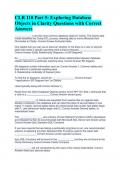Samenvatting
Political Participation & Protest: summary of all literature
This document includes summaries of all the articles that need to be studied for the exam of political participation and protest, a course given to political science students at the VU. The only article that isn't included is by Berckel Smit, Kroeze & Krouwel (2019): Understanding Varieties of Euro...
[Meer zien]













